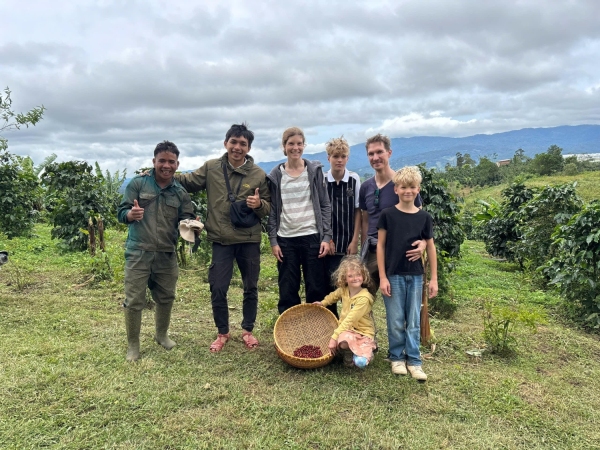
Soil is more than just dirt—it’s the foundation of all plant growth, including coffee. In sustainable coffee farming, understanding and nurturing soil health is the key to maintaining long-term productivity while preserving the ecosystem.
At HuyEco Farm, we recognize that soil isn’t just a passive medium—it’s a living system that interacts with climate, plants, and farming techniques. To maintain fertile land while minimizing environmental impact, we focus on two core techniques:
✔ Organic fertilization – Restoring nutrients using compost and plant-based materials.
✔ Soil coverage – Protecting the surface from erosion and maintaining moisture levels.
However, the practical application of soil coverage varies depending on the crop—while vegetable gardens benefit from a structured mulching system, coffee farms on steep terrain require a different approach.

Before applying organic fertilizers, soil analysis is crucial. At HuyEco Farm, I personally dig a 1x1x1 meter pit to collect soil samples for laboratory testing. This helps determine:
✔ Nutrient levels – Identifying what elements are lacking and how to replenish them.
✔ Soil history – Revealing past farming practices, erosion patterns, and chemical residues.
✔ pH balance – Understanding acidity, which affects plant health and microbial activity.
If soil lacks organic matter, it may show signs of depletion—thin topsoil, washed-out nutrients, and even increased weed growth (such as Imperata cylindrica, which thrives in acidic, degraded soils). By reading these signs, farmers and agricultural specialists can restore soil fertility through sustainable methods rather than relying on synthetic inputs.


Whether farming organically or conventionally, soil management follows the same fundamental principle—what is removed must be replenished.
Each year, coffee farms extract approximately 50kg of fresh cherries per tree, which means at least 50kg of organic nutrients must be returned to the soil. Instead of using synthetic fertilizers, we rely on:
✔ Coffee husks – Repurposing processing waste as nutrient-rich compost.
✔ Plant residues – Recycling organic matter to maintain microbial diversity.
✔ Biofertilizers – Enhancing decomposition and nutrient availability.
By investing in soil health, we ensure that coffee plants remain strong, delivering consistent quality yields without excessive environmental degradation.
Walking through the coffee agroforest—a thriving ecosystem where coffee plants coexist with diverse species, creating a sustainable and balanced environment for long-term farming.
At HuyEco Farm, sustainable farming isn’t just about coffee—it’s about creating a thriving ecosystem where crops support one another.
In our Robusta Coffee Tour, visitors witness how multi-crop farming enhances soil health, maintaining a dark, nutrient-rich topsoil that fosters biodiversity. Unlike monoculture farming, our approach aligns with traditional ecological wisdom that respects nature’s balance.
During our tours, we explain the contrast between conventional monocropping and sustainable multi-crop systems, demonstrating how these techniques preserve soil fertility, promote healthier coffee production, and reflect our deep-rooted respect for nature.

✔ Soil health dictates yield, sustainability, and long-term farm viability.
✔ Restorative practices, such as organic fertilization and biodiversity conservation, replace depletion with regeneration.
✔ At HuyEco, every farming decision reflects our commitment to environmental integrity.
🌱 If you’re passionate about sustainable coffee farming, visit us at HuyEco Farm and experience the balance between tradition, ecology, and modern cultivation firsthand! 🚀
📍 Explore more: HuyEco Coffee Tour
👉 HuyEco Coffee Tour – From Soil to Cup
Discover how HuyEco nurtures soil, cultivates coffee, and creates immersive sustainable experiences.
👉 Organic Coffee by HuyEco – Farm-Direct Products
Specialty Arabica & Robusta grown without chemicals, fully traceable from farm to cup.
👉 Hope, Challenges & Organic Coffee: A Young Farmer’s Journey
An inspiring story of a young farmer building a clean coffee livelihood along the Mekong.
👉 The Future of Arabica Coffee in a Changing Climate
Strategies to protect soil and adapt Arabica farming to climate change.
👉 Sustainable Coffee Farming: A Small-Scale Farmer’s Journey
Real-world insights into regenerative farming and soil restoration at HuyEco.
👉 Helena Coffee – Soil Improvement Techniques in Coffee Farming
Detailed guide on improving soil structure, managing pH, and boosting organic matter.
👉 Coffeelands – The Importance of Soil in Coffee Production
In-depth analysis of soil’s role and how to restore its ecosystem function.
👉 White Elk Coffee – Healthy Soil, Sustainable Coffee
Why healthy soil is essential for climate-resilient coffee farming.
👉 Era of We – The Complex Relationship Between Coffee & Soil Health
A global perspective on how soil affects coffee yield, quality, and sustainability.
Reader Comments
Newer articles
 Sustainable Coffee & Local Culture Tour in Da Lat — Arabica, Robusta & Ethical Farming
Sustainable Coffee & Local Culture Tour in Da Lat — Arabica, Robusta & Ethical Farming
 Discover Sustainable Coffee in Da Lat — A Farm-to-Cup Journey with HuyEco
Discover Sustainable Coffee in Da Lat — A Farm-to-Cup Journey with HuyEco
 Sustainable Coffee and Local Farming Realities in Da Lat HuyEc
Sustainable Coffee and Local Farming Realities in Da Lat HuyEc
 From Forest to Cup: A Personal Journey into Sustainable Coffee in Da Lat
From Forest to Cup: A Personal Journey into Sustainable Coffee in Da Lat
 Inside HuyEco: How a Coffee Huller Machine Transformed Our Coffee Production
Inside HuyEco: How a Coffee Huller Machine Transformed Our Coffee Production
 From Forest to Cup: A Farmer’s Vision for Sustainable Coffee and Local Travel in Da Lat
From Forest to Cup: A Farmer’s Vision for Sustainable Coffee and Local Travel in Da Lat
 Field Notes from Xã Lát: Rooted in Regenerative Coffee & Indigenous Farming
Field Notes from Xã Lát: Rooted in Regenerative Coffee & Indigenous Farming
 Đưng K'Nớ: Brewing Sustainable Coffee in Vietnam’s Highland Forest
Đưng K'Nớ: Brewing Sustainable Coffee in Vietnam’s Highland Forest
 Living Coffee Ecosystem in Da Lat – HuyEco’s Way of Growing
Living Coffee Ecosystem in Da Lat – HuyEco’s Way of Growing
 Nel Drip & Wabi-Sabi: Japanese Coffee Rituals at HuyEco Da Lat
Nel Drip & Wabi-Sabi: Japanese Coffee Rituals at HuyEco Da Lat